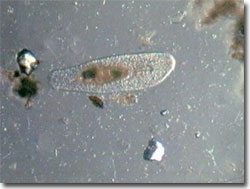Pond Life Digital Movie Gallery
Spirostomum (Protozoa) Movies
Known for displaying the fastest contraction of any living cell, the relatively giant ciliates in the genus Spirostomum are the true speed demons of the microscopic world. With some species large enough to be observed without the aid of a microscope, these protozoans can reduce their body sizes to 25 percent of their normal lengths in less than 8 milliseconds, using very strong myonemes.

Spirostomum Video #1 - A large individual grazes for food items among pond debris particles; under oblique illumination with a playing time of 26 seconds. Choose a playback format that matches your connection speed:
Spirostomum Video #2 - Internal anatomical features are clearly seen as this ciliate moves about searching for prey; under oblique illumination with a playing time of 16 seconds. Choose a playback format that matches your connection speed:
Spirostomum Video #3 - A foraging Spirostomum devours an unidentified green food item, which can then be seen through the transparent body among the other contents of the peristome; under oblique illumination with a playing time of 40 seconds. Choose a playback format that matches your connection speed:
Spirostomum Video #4 - An individual reacts to other microscopic creatures and soil particles that it encounters in pond water; under oblique illumination with a playing time of 36 seconds. Choose a playback format that matches your connection speed:
Spirostomum Video #5 - Several animals collide with one another as they move through the microscope viewfield; under oblique illumination with a playing time of 21 seconds. Choose a playback format that matches your connection speed:
Reaching lengths greater than 4 millimeters, a tremendous size for a single-celled animal, the entire body is covered with spiral rows of cilia. The cilia are used in unison for locomotion and to aid the ingestion of bacteria, algae, and other protozoans suitable as prey. The cilia create currents that flow toward the cytostome, or mouth, and drive food through the peristome. As ingested food fills a membranous sac at the end of the peristome, it closes off and breaks away, creating a large food vacuole. Digestion progresses and the vacuoles get progressively smaller. A water-expelling vesicle completes the notable anatomical characteristics of Spirostomum.
As representatives of the phylum Ciliophora (the ciliates) in the class Spirotrichia, Spirostomum species have well-developed fused mouth cilia that lead clockwise into the mouth. Unlike their relatives, the Paramecium, Spirostomum are elongated, cylindrical, and flattened in body shape. In addition to swimming with a coordinated ciliate movement, this large unicellular organism can move in a snake-like undulating manner. As occurs in other large single-celled organisms such as the giant Amoeba and Stentor, these ciliates often possess multiple nuclei forming a long strand, which may resemble a miniature string of pearls.
Contributing Authors
Cynthia D. Kelly, Thomas J. Fellers and Michael W. Davidson - National High Magnetic Field Laboratory, 1800 East Paul Dirac Dr., The Florida State University, Tallahassee, Florida, 32310.
BACK TO THE DIGITAL IMAGE GALLERIES
BACK TO THE OLYMPUS MIC-D DIGITAL MICROSCOPE
Questions or comments? Send us an email.
© 1995-2022 by Michael W. Davidson and The Florida State University. All Rights Reserved. No images, graphics, software, scripts, or applets may be reproduced or used in any manner without permission from the copyright holders. Use of this website means you agree to all of the Legal Terms and Conditions set forth by the owners.
This website is maintained by our
Graphics & Web Programming Team
in collaboration with Optical Microscopy at the
National High Magnetic Field Laboratory.
Last Modification Friday, Nov 13, 2015 at 02:19 PM
Access Count Since September 17, 2002: 28101
Visit the website of our partner in introductory microscopy education:
|
|
